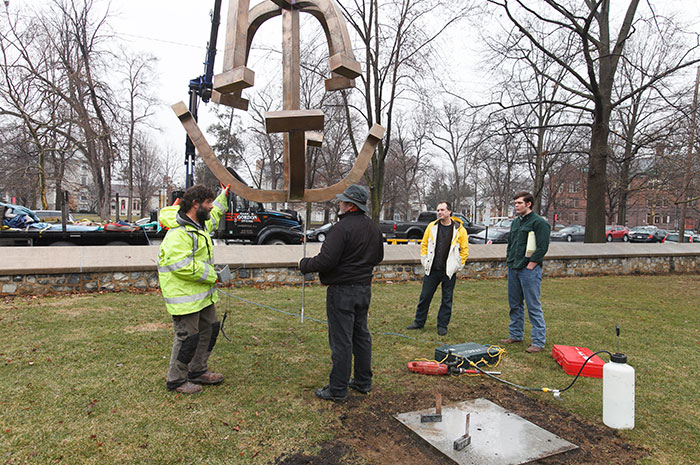'Art Can Do That'

Patrick Strzelec's nine-foot bronze sculpture was installed in front of the Weiss Center for the Arts on Friday, March 28. Above, Dickinson faculty and staff members watch as a crane lowers the artwork onto its base. Photo by Carl Socolow '77.
Unraveling the stories behind Dickinson's new landmark
By MaryAlice Bitts-Jackson
There are many double-takes on High Street this week, as passersby drink in a bronze, eight-foot form that appeared last Friday in front of the Emil R. Weiss Center for the Arts. It cuts an eye-catching figure on a campus that traditionally draws aesthetic interest from its stately architecture, lush flora and canopies of trees. For many campus residents and community members, the new structure automatically invites the question, "But what does it mean?"
The artist, Patrick Strzelec, titled the work “Negotiation,” and explains that it's a representation of the dialogues we engage in—internal and external, trivial and profound—throughout each day. But he's quick to note that the sculpture, commissioned last year by William '71 and Elke Durden, invites varied interpretations and sparks conversation, inspiration and debate.
For context, viewers can explore a new Trout Gallery exhibition of thematically similar works, created over two decades of Strzelec's career.
Top of the list
Born in 1956 in South Chicago, Strzelec earned a B.F.A. at Southern Illinois University in 1979 and an M.F.A. at Mason Gross School of the Arts, Rutgers University, in 1989. In the decades since, he was awarded the Rome Prize, the National Endowment for the Arts Award and a Guggenheim Fellowship for sculpture, and his work was shown in the U.S. and abroad. It is included in collections in the Newark Museum, Malin Collection, United States Holocaust Museum, James Michener Art Museum, Aldrich Contemporary Art Museum and Johnson & Johnson Collection.
Strzelec also has worked as the head of patination at the Johnson Atelier and as a patination and restoration consultant for the Polich Tallix Fine Art Foundry, where works by major artists and national treasures like the Statue of Liberty and the Liberty Bell are treated, cast and restored. He’s taught sculpture at the School of the Visual Arts in New York and at Harvard University before moving to Rutgers University’s Mason Gross School of the Arts in 2010, where he directs the university’s sculpture department.
A committee of art & art-history faculty members recommended Strzelec for the commission last year after reviewing the work of approximately 30 regional artists that were potential good fits. “At the top of that list was Patrick Strzelec,” said committee member Anthony Cervino, associate professor of studio art, adding that the committee was especially taken by sculptures Strzelec had exhibited in Berlin in 2006. Strzelec, who is represented by the Garth Greenan Gallery in New York, signed on and got to work.
Site as context
The first step was to create a small-scale model for temporary placement in front of the Weiss Center, with plans to create a towering steel structure as the final work. Next, the artist mocked up a full-sized form in foam and cardboard that could be sectioned into pieces and delivered to a foundry for casting.
“I soon realized that it was just too institutional—the scale was too big and the steel was too cold—to work in that space,” says Strzelec. So he re-scaled it and cast it in bronze, a metal with a warmer hue and a surface that retains a sense of the artist’s hand at work.
Back in his Bucks County, Pa., studio, Strzelec fabricated, welded and patinated the components, then sealed the form with wax. Once at Dickinson on March 28, the finished work was lowered by crane and fitted onto its base.
Strzelec plans to attend the April 4 reception at The Trout Gallery with his wife, Rutgers dean Lisa Baratta, and sons, Lucas, who helped fabricate the structure, and Sam, a filmmaker who collaborated with his father to create a video installation for the show. As a longtime educator, Patrick is pleased that his latest work finds a home on a college campus and notes that the sculpture's theme touches on the dialogues and processes that are part of the learning process.
Cervino, who leads a public-art class this semester, adds that the sculpture's lively, fluid form also elegantly expresses "growth through choice," signaling the intellectual and artistic vibrancy of the Dickinson community and the momentum of the institution as a whole. But he also echoes Strzelec's caveat that the fine points of the interpretation may be different, viewer to viewer. And rightly so.
"That's how conversations begin, and that's why public art is so valuable," Cervino says. "Art can do that."
Video by Joe O'Neill
Alejandro Heredia ’16 contributed to this story.
Learn more:
- About the exhibit and ceremony
- Colorful Lives: Public Art Wall
- Sustainable Art Project
- The Arts at Dickinson
- The Trout Gallery
- Calendar of Arts
Published April 3, 2014